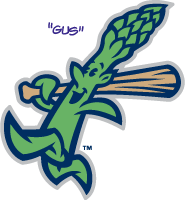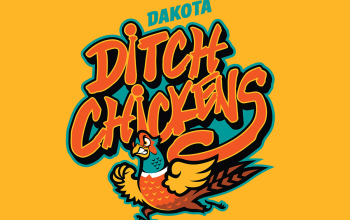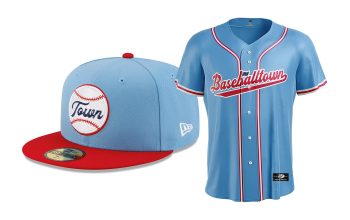Stockton, California, is the asparagus capital of the world. The stinky green stalk is one of the San Joaquin Valley’s major crops, and the city of Stockton is home to the San Joaquin Asparagus Festival, which celebrates all things asparagussy. The problem is, Hadley Massachusetts; Oceana County, Michigan; and Isleton, California, also lay claim to the title asparagus capital of the world—and those are just asparagus capitals of the world in the USA. The crop was cultivated by the Greeks and Romans, so who knows how many international asparagus capitals of the world there are?

Stockton, California, also lays claim to being the inspiration for the fictional town of Mudville in Ernest Thayer’s classic 1888 poem, “Casey at the Bat.” Stockton went by the nickname Mudville in the 1800s, and Ernest Thayer was known to have attended games there, covering baseball for the San Francisco Examiner in 1887.
The only problem is, Thayer grew up in Worcester, Massachusetts, very close to a town called Holliston, which has a well-known neighborhood called Mudville. In fact, the pro-Holliston faction points out, Thayer’s family owned a mill about a mile from Mudville. Thayer himself was noncommittal on the subject, saying only that the poem was fiction.
One thing that no one can take away from Stockton is that it’s home to the largest inland seaport in California. The Port of Stockton, roughly 80 miles east of San Francisco Bay on the San Joaquin River, officially opened in 1932, but the city has played host to seafaring vessels since the 1860s. It’s because of this incontrovertible fact that the High-A California League Oakland A’s affiliate in town has its name.
“The big thing about Stockton is the fact that we have this massive port, which actually runs into the San Francisco Bay,” said the team’s director of marketing Taylor McCarthy. “Being that we’re right on the port, it was just kind of a natural fit.”
 Stockton was a charter member of the current iteration of the California League, when the team debuted as the Stockton Fliers in 1941. After the league shut down operations for World War II, the team came back as the Stockton Ports in 1946.
Stockton was a charter member of the current iteration of the California League, when the team debuted as the Stockton Fliers in 1941. After the league shut down operations for World War II, the team came back as the Stockton Ports in 1946.
They’ve gone by that name every year since, except for a two-year stint in 2000-2001, when they were formally known as the Mudville Nine (basically a stick in the eye to those weasels in Holliston, Massachusetts).
Since 2005, the Ports have played in Banner Island Ballpark, located right on the banks of the river in an area known as Mudville. So, take that, Holliston.
The team’s identity is classic and conservative, with a red, white, and blue color scheme and a traditional feel that’s been a staple since 2002.
“The primary logo that we’ve had for a long time now is that one with the baseball and the bats in the background, and it has the Ports script around it,” McCarthy said. “On our home uniform, we use a red cap, and that’s with an S and the anchor with the baseball—the anchor going with the delta theme and we’re right on the water…. Then when we’re on the road, we have a P-anchor hat, you know, P for Ports.”
So everything to do with the Ports is classic and traditional, except…
In 2013, the Ports brought in the guys from Brandiose, and flying in the face of those posers from Hadley Massachusetts; Oceana County, Michigan; and Isleton, California, the Ports speared their city’s claim to chief asparagus-dom.
“Stockton is the asparagus capital of the world,” said Jason Klein of Brandiose. “They have an asparagus festival every year. They also wanted to incorporate a new character, so we dreamed up a tattooed stevedore named ‘5 O’Clock Dock.'”

Every Friday home game, the Ports take to the field in asparagus-themed uniforms, with caps that feature 5 O’Clock Dock, meant to represent not just the agriculture of the area, but the local population.
 “The term Five O’Clock Dock is 5:00, you’re punching out, and he’s a dock worker,” McCarthy said. “It was a very good way to relate to the blue collar city, the every-day, 9-to-5 workers that are a big part of the Stockton community.”
“The term Five O’Clock Dock is 5:00, you’re punching out, and he’s a dock worker,” McCarthy said. “It was a very good way to relate to the blue collar city, the every-day, 9-to-5 workers that are a big part of the Stockton community.”
The asparagus theme continues with the team’s kids club logo, Running Gus. (Get it?) On a side note, we can only hope that Running Gus and the Wilmington Blue Rocks’ Mr. Celery never meet in a dark alley. Imagine the carnage.
Of course, the new look was not immediately beloved. “When they introduced it, it was definitely different, maybe took people a little bit of a while to get used to it,” McCarthy said. “But now people, they love the logo.”
Having an alternate identity that’s completely different from a primary is not unheard of in minor league baseball—the Reading Fightin Phils Baseballtown alternates are the poster child for that sort of thing. But the disparate identities of the Ports seem to present a unique challenge. The team’s primary logo is from 2002, but it feels older, an homage to a team that dates back to the 1940s, and a city whose baseball history extends to almost mythical status in the 1860s. The asparagus-based alternate, on the other hand, is certainly the product (produce?) of minor league baseball’s new era, where unique and fun take precedence over classic and traditional.
The Ports make it work, though, and the team’s identities—both of them—are well received. “In fact,” McCarthy said, “we’re usually one of the top 60, 65 caps in minor league baseball, when they do the fan vote.” Not bad for a Single-A team competing against 159 other teams.
So while there is no joy in Mudville—whether it be in California or Massachusetts—there is asparagus, and there is a giant inland seaport in Stockton, and more than a century’s worth of baseball tradition is carried forward on the shoulders of a vegetable named Gus.












